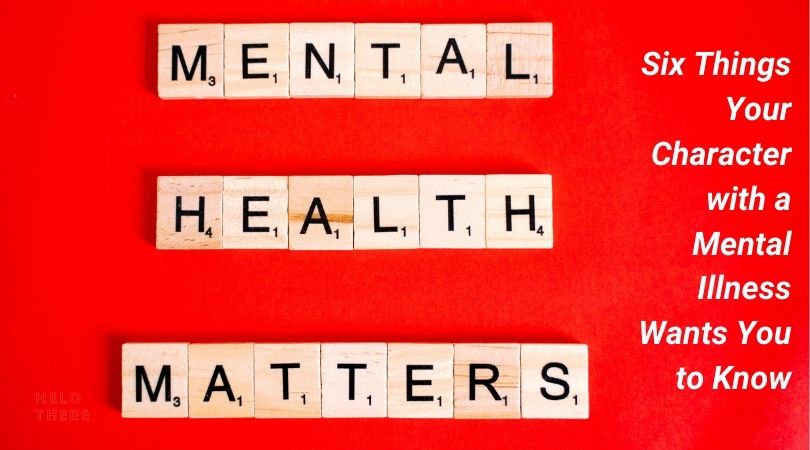craft post by Sarah S. Davis
Many kids that experience mental illnesses start developing symptoms as young teens–just when they’re at the age to encounter Young Adult literature. Through YA novels, writers can reach readers at this critical time. Young adult books can be a balm to teens struggling with mental health, offering disability representation, much-needed hope, and comfort in knowing that they’ll come through their darkest days… if we follow a few key guidelines. These six pointers are indispensable in creating an empathetic, accurate, and hopeful book with mental health themes.
1) Do your research
It should go without saying, but research is everything when you’re aiming for accurate and sensitive representation of characters with mental illness. Consulting general online and print resources are a great way to start learning the facts about people with these conditions. But facts and figures can only take you so far. It’s just as important to research lived experiences with mental illness. Fortunately, you can find out more about living with mental health challenges through blogs, social media, and, especially, YouTube.
2) Get the medication details right
Nothing says “I haven’t done my leg work” like seemingly tiny inaccuracies. One big one that sticks out like a sore thumb is medication. It’s absolutely true that psychiatric medicine is a massive industry with more drugs than anyone can hope to master. But they are not all the same, and when you’ve prescribed your character the wrong kind of medication, it sticks out. If you can’t consult with a psychiatrist, be sure to find someone real who takes psych meds and ask for their first-hand knowledge and experience with psychopharmaceuticals.
3) Consult a sensitivity reader
To really ensure you’ve written an accurate representation of life with mental illness, consult a sensitivity reader. Try the directory on Writing Diversely or reach out on Twitter to find someone who’s a match for your story and your character’s mental health challenges. Investing in a sensitivity reader (or two!) can help you avoid any issues with any potentially problematic depictions of mental illness before publication. (Do expect to pay sensitivity readers and expert readers or to trade some of your expertise for some of theirs.)
4) Don’t try to “cure” the condition
Too often, stories about mental health imply either subtly or obviously that something or someone can “cure” the character with a mental illness. No, love doesn’t cure bipolar. No, schizophrenia can’t be cured by a swoon-worthy dream boy. No, getting medication can’t “cure” your protagonist with OCD. All mental health conditions are treatable, but few improve from just one factor. Treatment for mental illness often requires a holistic approach, including psychiatry, psychotherapy, medication management, exercise, sleep hygiene, and the list goes on. It’s dangerous to give readers the idea that mental illness is curable with the right magic bullet. Grappling with the chronic, life-long aspect of mental illness is part of the process, one that can cause turbulent emotions—anger, denial, grief—that deserve space and respect. That said, while you won’t want to “cure” your character, you do want to offer some hope, which brings us to the next recommendation.
5) Offer hope
It’s crucial that authors offer the potential of hope to young readers. That’s not to say that characters or readers should be shielded from the harsh truths of mental illness. Many people who have a mental illness feel hopeless and vulnerable, particularly in the earliest days after receiving a diagnosis. These feelings often correspond with the so-called Dark Night of the Soul plot point. Do allow your characters to grieve the “normal” life they once hoped for, but please don’t leave your characters with no possibility of hope, which can come in many forms–an understanding therapist, an ally or friend, understanding parents or guardians, a kind teacher or librarian, and a medication that would help treat symptoms and make life bearable.
6) Include backmatter
Providing relevant backmatter is the responsible thing to do when publishing books with mental illness themes. Include hotlines, blogs and websites, chat rooms, support groups, and links to national advocacy and support organizations. Don’t leave readers hanging without connecting them to resources that could support them and very well save their lives.
Exemplary Mental Health YA
As you embark on writing a book with mental health themes, looking to other authors who’ve done it well can be one of the best resources. The books below all handle mental health issues with care and consideration–the characters have diagnoses, but they are not only their diagnoses. Study them to discover new ways of engaging with mental illness in your own work.
- Pick one or two that deal with similar mental illnesses that are in your book.
- Notice the details, emotions, nuances, and hope in the stories.
- Note how mental health might be a central part of the story, the core of the story, or the context for the story.
- Look for how these characters are developed within and beyond their mental health diagnoses. What are their core relationships, hopes, and dreams? How do they extend beyond a diagnosis? How are they framed or shaped by the diagnosis?
- Take what you learn from the mentor texts and apply it to your work in progress.
Recommended Books
Ford, Michael Thomas. Suicide Notes (2008)–Depression, Anxiety
Green, John. Turtles All the Way Down (2017)–OCD
Kaufman, Caroline. Light Filters In: Poems (2018)–Depression
LaCour, Nina. We Are Okay (2017)–Grief
Leavitt, Martine. Calvin (2015)–Schizophrenia
Niven, Jennifer. All the Bright Places (2015)–Bipolar Disorder, Depression
Quick, Matthew. Every Exquisite Thing (2016)–Depression
Rowell, Rainbow. Fangirl (2013)–Bipolar Disorder, Anxiety
Stevenson, Noelle. The Fire Never Goes Out (Memoir) (2020)–Bipolar Disorder
Stone, Tamara Ireland. Every Last Word (2015)–OCD
Sones, Sonya. Stop Pretending: What Happened When My Big Sister Went Crazy (1999)–Bipolar Disorder
Whaley, John Corey. Highly Illogical Behavior (2016)–Agoraphobia
NOW IT’S YOUR TURN
As an exercise, pick a mental illness you are not familiar with. (You can also follow these steps with a mental illness that shows up in an existing draft.)
- Research medication and treatment options.
- Go deeper and look for blogs and YouTube channels for content created by those with the illness.
- Take notes on a few tiny details about living with the condition that you would not have known without consulting lived experiences.
- Then write a scene that includes some of those aspects of life with the illness in an organic way.
Even if you are writing out of your own experience or the experience of someone close to you, digging into research can give you opportunities to expand your story.
Enjoyed this post? Read more:
EVOLVING SYMBOL IN HIGHLY ILLOGICAL BEHAVIOR BY JOHN CORY WHALEY by guest contributor Jesaka Long
CONTROLLING BELIEFS by Anne-Marie Strohman (which includes a discussion of Martine Leavitt’s Calvin)

Sarah S. Davis lives among cats and piles of books outside Philadelphia. Her writing has appeared on Book Riot, Electric Literature, and Kirkus Reviews. She holds a BA in English form the University of Pennsylvania and a Master’s of Library Science from Clarion University. Sarah is currently an MFA student in Vermont College of Fine Arts’ kid lit program. She is working on a middle grade fantasy novel, a YA dystopian series, and collection of nonsense verse. Besides reading books, Sarah also reads tarot cards professionally.
Find Sarah on her blog, Broke by Books.





COMMENTs:
0